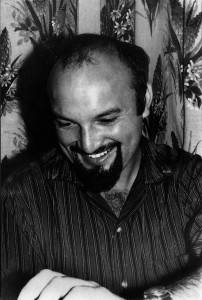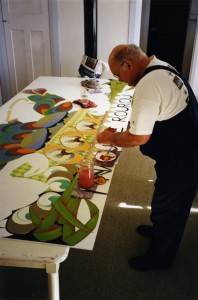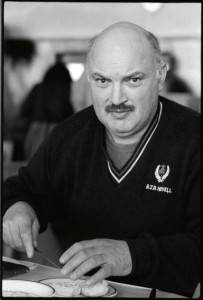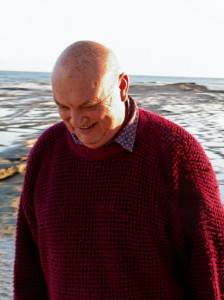Rollo John Richard Hovell (1937-2014)
Rangihīroa Panoho
Reverend John Hovell died of cancer in the early morning of Wednesday, June 4 2014. He was an extraordinary person with enormous energy and capacity for processing all manner of intellectual and aesthetic material from around the South Pacific as they directly pertained to Māori. He is greatly missed by many students, artists and friends who knew and cared for him. He was a Māori artist who possessed a rare combination of abilities. He had an enquiring eye, a perceptive spirit and a ferocious intellectual appetite.
Hovell left us at the height of his powers both as an artist and as a thinker. He was finally receiving justly deserved recognition for a lifelong exploration of and dedication to kowhaiwhai in both the New Zealand gallery and in dining hall and meetinghouse spaces within Māoridom.

John Hovell, 1967
photograph: John Selby
Creativity was not something easily surrendered. He was still working on at least two major projects while receiving heavy doses of chemotherapy for leukaemia. ‘January and February 2012’ he wrote, ‘just went off in a chemical haze and [a] terrible feeling of lassitude’. Regardless he completed work for two projects in Thames. The last series of work he showed me was a collection of prepared boards neatly stacked against his diningroom wall. They had an early preparatory structure sketched in pencil and expertly repeated freehand. These would decorate pillars and a ceiling as a final koha ‘gift’ for treatment received at the local hospital in nearby Thames, Coromandel.
What many may not recognise with this quietly spoken, private man was his keen intellect and the major contribution he made to the lives of others through his writing. I am not describing published work but rather the much more personal encouragement and deep thinking he offered through correspondence (from which I deliberately quote because I think Hovell’s words are the more essential ones and have never reached the kind of broad audience with which they also deserved to connect). It is what Hovell had to say through all these years that is of far greater importance than solely the visual part of his legacy. I have never really thought of a separation between Hovell the intellectual or educator and Hovell the artist. The two were, in his work, symbiotically one thing.
His key texts were his many letters (I was a happy recipient on and off over nearly 30 years). They came penned, always handwritten in black fountain ink, on lined paper, note and A4, and with quicker summaries in the more convenient 1 and 1/3rd page Aerogram. If none of these materials were available communication reverted to the reverse of prints, xeroxed maps of tropical islands or the back of someone else’s research on Polynesian material culture: really whatever was at hand. He wrote in a novel – like tempo with, fluid streams of thought. Paragraphs came in rivers.
Correspondence with Hovell was immediately recognisable and often accompanied by postage stamps from some distant Pacific Island. It was not unusual to receive letters on or with maps indicating visits to Polynesian outliers or perhaps to distant Rapanui, xeroxed illustrations of some current research interest in which he was engrossed at the time.
He was a keen observer and someone who understood the ironies that life brings. It is perhaps paradoxical that I quote so much here from Hovell himself. He was a dignified, quiet, intensely private man with a mischievous sense of humor and a probing sense of commentary. Yet it is in his words and his imagery that Hovell looms grand and larger than life. If anyone has doubts about that they only need look at a major work like his ceiling inside the Harataunga meetinghouse Rakairoa, 1995.

John Hovell painting the Rongomaitapui mural, 1999
photograph: Vivienne McConnell
Hovell also seemed the kind of person who might not speak a lot directly about something but sooner or later conversations seemed to prompt voluminous correspondence. It was in his text and in his art that he seemed to be most expressive and happy to explore unhindered by the interjecting voice of the recipient. He drew extensively on a rich repertoire. It was a life full of the most fascinating collection of experiences and memories. Many of these were important revelatory moments that clarified an idea or perhaps suggested new directions in his art or something that he was seeking to understand about pattern or cosmology. While travelling on an inter-semester break aboard the ‘Southern Cross’ (the Church of the Melanesian Mission ship) he describes passage, ‘…past endless green-ringed, white sanded islands and lagoons…I look hard at the islands trying to etch their symmetries in the retina – for I believe the shape of people’s stories are related to the shape of the islands, landscapes, landforms and natural things…Images and islands reflect each other.’ 26 June 1989
Obituaries are also reflective. They pay precise attention to facts and figures regarding the life of a person. Some of these have already been made public. Hovell grew up in Harataunga ‘Kennedy’s Bay’, Coromandel Peninsula. Although he proudly connected with both his Ngāti Porou and his Ngā Puhi affiliations – this particular heavily bush clad spot on the coastline at Harataunga, once the home of nineteenth century whaler/trader John Kennedy, was the playground of his childhood and his hau kainga ‘ancestral homeland’.
It was not easy access to get to him. I baulked at his idea of driving the family car at low tide around the coastline. In the end we took the easier route over the steep winding hill down to the site of the original homestead. I was lucky enough to visit Hovell on home soil (prior to his finally moving back to the less remote township of Coromandel over the dividing range to the other side of the peninsula). The whole connection with Kennedy (who married into Hovell’s hapū seemed as important a legacy as the Ngāti Manu leader Pōmare (who fought at sites around the East Coast in the 1820s) from whom the artist was also proud to mention descent.
Hovell attended Kennedy’s Bay Native School during the forties, then was sent by his parents to board at Mt Albert Boys’ Grammar School in Owairaka, Auckland (1952-1956). He went on to complete a Bachelor of Arts majoring in English Literature at the local University (1957-1959). He studied other subjects including anthropology, ancient history and its connected classical languages. Teaching was in the family. Both his parents were in the profession and their son, while an educator for much of his working life, was also a perpetual student.
This seems an important distinction. Hovell loved knowledge and personal research but not simply that located within institutions. He travelled widely to gather valuable experiences and to deepen ongoing research through the entirety of his life. His search took him to many out of the way places both in regional New Zealand and, for lengthy periods of time, on remote islands throughout the South Pacific. Hovell taught in Rarotonga, Solomon Islands College of Higher Education in Honiara and travelled for twenty years (according to the artist) around its far flung islands and across the Polynesian triangle to Papeete and as far east as Rapanui. He was a collector of experiences and he carried them with him where he went. He was not one to easily forget legacy. Of his first year in the Solomons (two terms of 20 weeks each with a five week break in July) he wrote of his prior teaching in the Hawkes Bay, ‘I have left Te Aute [College] behind only in the physical sense, the magic of that school stays with me.’ 4 May, 1988
There was a certain willing deprivation in these sojourns and he despaired at the materialism in New Zealand that overwhelmed him on his many returns from the islands. One description of living conditions in the Solomons encapsulated the difficulties he gladly accommodated in pursuit of his research and his teaching. ‘Life always had a certain degree of ad hoc disorganisation (not improved by 20 years of Solomons pandanus thatched huts with adzed mangrove flooring…and a cold water pipe on a waterstand somewhere within reach, if I was lucky).’ 9 April 2012. He described the holiday break in July as, ‘…relief from mosquitos, mud, malaria, and overflowing water-logged septic tanks, and food crops rotting in the ground.’ 26 June 1989

John Hovell
photograph: John Miller
At the same time as Hovell was travelling widely in the Pacific his own reading and writing regularly took him in surprisingly different directions. These seemed to involve numerous occassions in finding the familiar in the strange or distant. At times one locates in his recollections a search for twentieth century Māori in the cultural histories of distant countries or of orthodox Māori in the village cultures of the South Pacific. At one stage Hovell wrote regarding his interest in creating a thesis in anthropology on the knot patterning of Tikopia, the Polynesian outlier made famous by Firth, in the Solomons while based at the Selwyn College in Honiara (1988 -1998).
A more abiding obsession was the American South and comparison between the Māori and the Southern novel and post-war (i.e WWII) population relocations, ‘I read through the cycles of novels, such as those of William Faulkner every decade or so, I should say re-read, and currently I’m going though the Louisiana novels of Ernest J Gaines. I wrote to the old fellow in his plantation retreat a few weeks back, to tell him how much his writing has meant to me over the past forty years. I just hope he is still alive…Southern literature explores that enormously rich interplay between Indian, Cajun, white, coloured, Negro mores, expectations, history, sorrows, tragedies.’
It was not just Southern literature that fascinated the artist. Any Western literature was fair game for descriptive annotation. In my last correspondence 2011-2013 Hovell uses Shakespeare’s ‘Macbeth’ to conjure up an image that does justice to the important Māori painter Ralph Hotere and his use of the colour black. He is describing an, ‘…idea of black containing all colours held in subjection or yielded up as black feels fit to do so…’ This involved his helping an expert dyer mix two kerosene tins full of boiled hīnau and plant material sludge into her paru, ‘As I watched she stirred them into the swamp bath with a large wooden spatula, muttering all the while. I didn’t ask, “Aunty, why are you talking to your paru?” (It was too much like the witches in Macbeth, casting spells over their cauldron). But I did ask, “Will this make a rich dark black?” She said, “Not just black, but all colours are in there – greys, purples, browns – the paru will decide which colour to give to the fibre. For someone brought up to believe that all colours are in white light…this was quite a revelation, a leap in acceptance’
He was an inquisitive thinker and his schooling moved like the Harataunga tide with an easy ebb and flow. Writing ironically about education away from his beloved Kennedy’s bay home he noted, ‘I loathed grammar schooling, as much as my classmate and relative Bob Mahuta did. The best thing was that he…did all my maths homework for me, and I did his Latin and French for him…In the end he packed it in, and went down the mines, while I struggled on to Uni…(years later I laughed about this when I was sweating it out in East Coast shearing sheds, and Bob went off to Oxford to do his Doctorate…It’s a funny old life.’ 9th April 2012
Hovell believed in cycles of change both in the cultural, human and in the natural environments. His paintings and his thinking are full of these repeating patterns. Although Hovell did stretches of itinerant work (like shearing) after moving back to the East Coast (1967-1982) his first job, after an intensive one year course at Hamilton Teachers’ Training College (1965), was as a teacher at the local college at Te Araroa, East Coast. The year in Hamilton also involved mentoring outside the context of the classroom. Hovell had his first real involvement in thinking and creating contemporary Māori art through contact with Te Whānau-ā-Apanui artist Paratene Matchitt. The Māori Arts and Crafts Advisor for the Education Department (based in Hamilton and covering the South Auckland region) was to be an important mentor and a lifelong inspiration for the younger teacher trainee.
It was Matchitt who encouraged Hovell to work alongside him on a 1965 carving commission in Hamilton. Indeed it was Matchitt who also suggested he deepen his studies further by living near the Ngāti Porou carver and tribal historian, Pineāmine Taiapa (then based on his family farm at Tikitiki). Taiapa had a major impact on a whole generation of younger Māori artists. Hovell was one of many who benefitted from the input of the tohunga in his twilight years prior to his death in early 1972. Again one senses in Hovell’s various recollections of time spent with Taiapa that he drew inspiration from the particularly experiential way in which Taiapa told stories and practiced his art.

John Hovell, Horoera 2010
photograph: Studio La Gonda
As Hovell’s comments regarding the Southern novel indicate he came from a post World War II generation that saw enormous change in the Māori way of life. He witnessed the mass urban drift of tāngata whenua to New Zealand’s towns and cities. Indeed Hovell’s art and his writing was part of a major shift in the indigenous response to and engagement of Western art and culture. Hovell saw himself as centrally involved in this process. He was one of a small group of intellectuals and artists at the core of changes being brought to Māori visual and written culture from the 1950s onwards. He was involved with the organizing of the inaugural meeting of the Māori Artists and Writers conference at Tukaki Mārae, Te Kaha in 1973 and he exhibited regularly with the other major Māori artists.
There are points of comparison that can readily be drawn between the work of Hovell and friends like the painter Sandy Adsett who also has committed much of his productive career to researching kowhaiwhai. Some senior Māori artists resent being described as the products of mentors like Taiapa. Hovell has also been identified as working under the late carver Paki Harrison. The more important truth is they were both whānaunga and belonged to the same hapū there at Harataunga. Both collaborated on important projects (Tānenui-a-Rangi meetinghouse, Waipapa, Tāmaki, 1988 and Rakairoa, Harataunga, 1995) and both had an enormous respect and a caring admiration for one another. Harrison wrote publically of the 1988 project that Hovell was, ‘…one of Maoridom’s most gifted artists and a recognised authority on kowhaiwhai painting.’ Hovell wrote to me that, ‘Pakariki Harrison would never comfortably be cast in the role of closed orthodoxy, and was much more likely to be attacked or admired for his open-mindedness.’
The insight was one of many that fill John Hovell’s letters and his art and I will miss their being cut off by this lengthy battle with leukaemia. The second time I visited him on a late summer in early 2014 he was too ill and had taken to his bed. I realised he was sleeping and farewelled him through heavy curtains. They were drawn across the windows in the late afternoon. A large tui swooped past me very closely and off into an adjoining pocket of Coromandel bush. It sat up on one of a number of natives that filled a gully near one of the cottages his great friend, the artist Dr Deidre Airey, had set aside for the elderly and the terminally ill. I took the visit of the songbird, the manu tiaki, as a tohu ‘portent’. I left sad, but satisfied that the tui had spoken words as soothing and melifluous as those of the one who slept in peace near his perch. Tai pari, tai timu, te rere o Harataunga. E te rangatira, okioki ki te poho o te Atua. Haere ki Hawaiki nui Hawaiki roa Hawaiki pamamao haere atu ra.
 In 2006, after fifteen years of collaborative art practice, Susan Jowsey and Marcus Williams decided to invite their two children, Jesse and Mercy to join their art project, creating the art collective, F4. The body of work selected for this publication, forms part of that seven-year journey; the making of this work became part of their family life. As the project progressed, the family and its dynamics became the conceptual source for the work…
In 2006, after fifteen years of collaborative art practice, Susan Jowsey and Marcus Williams decided to invite their two children, Jesse and Mercy to join their art project, creating the art collective, F4. The body of work selected for this publication, forms part of that seven-year journey; the making of this work became part of their family life. As the project progressed, the family and its dynamics became the conceptual source for the work… For F4, this alludes to a human tendency in perceiving the isolated moment or detail very clearly, but failing to comprehend the singularity within a continuum of significance. Photographs themselves compound this, by locking a moment in time, in a way that no other phenomena can achieve, at least not with such veracity and vivacity. Photography destabilises the natural order of things, allowing us to hold the present in our hand as a print, even as the present eludes us…
For F4, this alludes to a human tendency in perceiving the isolated moment or detail very clearly, but failing to comprehend the singularity within a continuum of significance. Photographs themselves compound this, by locking a moment in time, in a way that no other phenomena can achieve, at least not with such veracity and vivacity. Photography destabilises the natural order of things, allowing us to hold the present in our hand as a print, even as the present eludes us…










